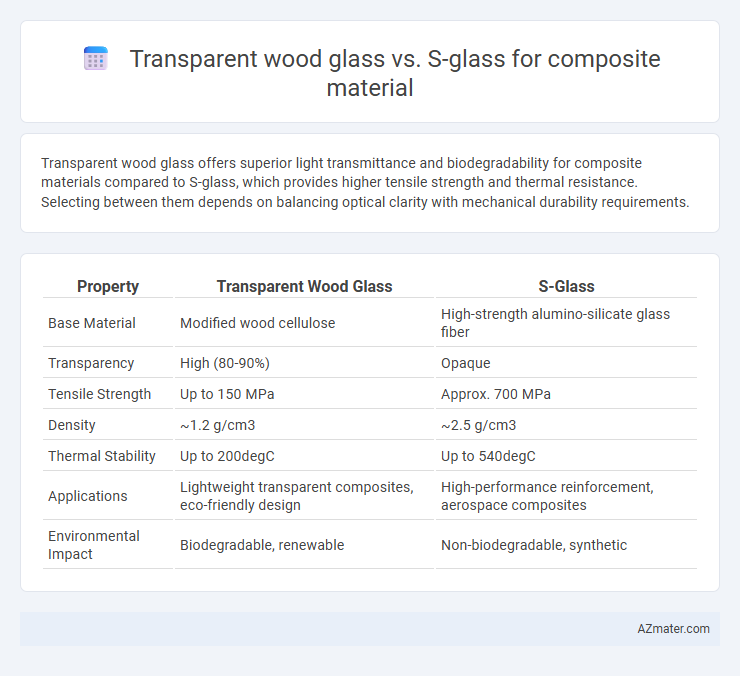Transparent wood glass offers superior light transmittance and biodegradability for composite materials compared to S-glass, which provides higher tensile strength and thermal resistance. Selecting between them depends on balancing optical clarity with mechanical durability requirements.
Table of Comparison
| Property | Transparent Wood Glass | S-Glass |
|---|---|---|
| Base Material | Modified wood cellulose | High-strength alumino-silicate glass fiber |
| Transparency | High (80-90%) | Opaque |
| Tensile Strength | Up to 150 MPa | Approx. 700 MPa |
| Density | ~1.2 g/cm3 | ~2.5 g/cm3 |
| Thermal Stability | Up to 200degC | Up to 540degC |
| Applications | Lightweight transparent composites, eco-friendly design | High-performance reinforcement, aerospace composites |
| Environmental Impact | Biodegradable, renewable | Non-biodegradable, synthetic |
Introduction to Transparent Wood Glass and S-Glass
Transparent wood glass is an innovative composite material combining lignin-modified wood fibers with polymers, offering high transparency, excellent thermal insulation, and sustainability. S-glass, a high-strength fiberglass variant, provides superior tensile strength, heat resistance, and durability for demanding composite applications. Both materials serve distinct purposes in advanced composites, with transparent wood glass emphasizing eco-friendly, lightweight properties and S-glass focusing on mechanical performance and structural integrity.
Material Composition and Structure Comparison
Transparent wood glass is composed of cellulose fibers extracted from natural wood, combined with a transparent polymer matrix that enhances optical clarity and mechanical strength, creating a lightweight, biodegradable composite. In contrast, S-glass consists of high-strength fiberglass with a silica-alumina-boron composition, producing superior tensile strength and corrosion resistance ideal for aerospace and military applications. The microstructure of transparent wood glass exhibits a porous, fibrous framework impregnated with resin, whereas S-glass features continuous glass fibers with smooth surfaces embedded in a polymer matrix, resulting in significantly different mechanical and optical properties.
Manufacturing Processes of Transparent Wood Glass vs S-Glass
Transparent wood glass manufacturing involves a delignification process to remove lignin from wood, followed by impregnation with a transparent polymer resin to enhance optical clarity and mechanical strength. In contrast, S-glass production requires melting raw materials such as alumina and silica at high temperatures, then rapidly drawing the molten material into fine fibers to achieve superior tensile strength and thermal resistance. The manufacturing of transparent wood glass emphasizes eco-friendly processing and translucency, while S-glass focuses on high-performance fiber extrusion for composite reinforcement.
Mechanical Properties: Strength and Flexibility
Transparent wood glass exhibits increased tensile strength and enhanced flexibility due to its cellulose-based structure combined with polymer infiltration, offering superior impact resistance compared to conventional materials. S-glass, a high-strength fiberglass variant, provides exceptional tensile strength and stiffness, with higher modulus values but lower flexibility relative to transparent wood glass. While Transparent wood glass balances strength and pliability for dynamic applications, S-glass excels in rigid, high-load scenarios requiring maximum durability.
Optical Properties: Transparency and Light Transmission
Transparent wood glass exhibits higher transparency and superior light transmission compared to S-glass, making it ideal for applications requiring natural lighting. The unique cell structure of transparent wood allows for efficient light diffusion while maintaining structural strength. S-glass, though strong and durable, typically offers lower transparency and reduced clarity due to its fibrous composition.
Thermal Insulation and Conductivity
Transparent wood glass exhibits superior thermal insulation with a low thermal conductivity of approximately 0.12 W/m*K, significantly reducing heat transfer compared to S-glass, which has a higher conductivity around 1.2 W/m*K. This makes transparent wood glass an excellent choice for energy-efficient composite materials where minimizing heat loss is crucial. S-glass, while offering high mechanical strength and thermal stability, does not match the insulating properties of transparent wood glass in composite applications.
Environmental Impact and Sustainability
Transparent wood glass composites offer significant environmental benefits through their renewable wood fibers that reduce carbon footprint and energy consumption compared to synthetic S-glass, which relies on energy-intensive manufacturing and non-renewable raw materials. The biodegradability and lower greenhouse gas emissions of transparent wood glass enhance its sustainability profile, making it a preferable option for eco-friendly composites. S-glass, while strong and corrosion-resistant, presents challenges in recycling and environmental persistence, limiting its overall sustainability compared to bio-based transparent wood glass materials.
Cost Analysis and Scalability
Transparent wood glass offers a cost-effective alternative to S-glass in composite materials due to its lower raw material expenses and simpler manufacturing processes, resulting in reduced overall production costs. While S-glass provides superior mechanical strength and thermal resistance, its high energy consumption and costly fiber manufacturing hinder large-scale production. Transparent wood glass demonstrates promising scalability prospects with sustainable sourcing and eco-friendly processing, making it a competitive option for cost-sensitive and large-volume composite applications.
Applications in Composite Materials
Transparent wood glass offers lightweight, high-strength solutions ideal for sustainable construction and automotive panels due to its excellent optical clarity and mechanical durability. S-glass, known for superior tensile strength and thermal resistance, is predominantly used in aerospace, marine, and high-performance sports equipment where structural integrity under extreme conditions is critical. Composite materials utilizing transparent wood glass excel in energy-efficient building facades, while S-glass composites dominate applications requiring enhanced impact resistance and long-term durability.
Future Prospects and Research Directions
Transparent wood glass offers promising advancements in sustainable composite materials, exhibiting enhanced mechanical strength, optical clarity, and biodegradability compared to traditional S-glass fibers. Future research is likely to focus on optimizing the interface bonding, scalability of production processes, and multifunctional applications such as energy-efficient building materials and lightweight structural components. Innovations in chemical modification and hybrid composites could further improve durability, thermal stability, and environmental impact, pushing the boundaries of transparent wood glass as a viable alternative to conventional S-glass composites.

Infographic: Transparent wood glass vs S-glass for Composite material
 azmater.com
azmater.com